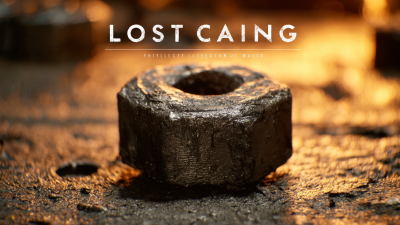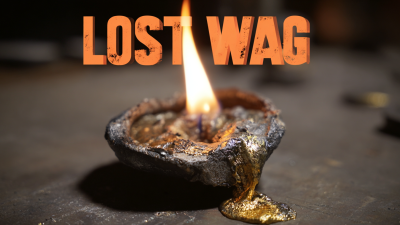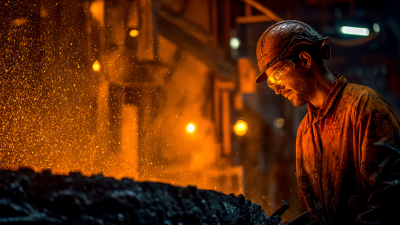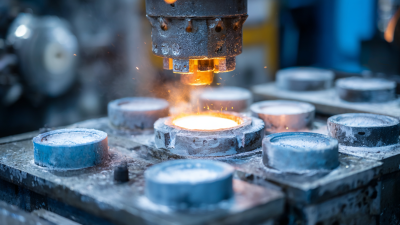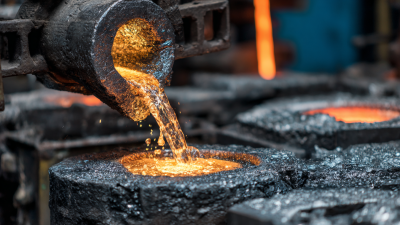 +86 180 0293 5268
+86 180 0293 5268






 Investment casting is a time-honored manufacturing process that has been revolutionized by advancements in technology, offering unparalleled precision and versatility in producing complex geometries. According to a recent report by MarketsandMarkets, the global investment casting market is projected to reach $25.2 billion by 2026, growing at a CAGR of 5.4% from 2021. This growth is driven by increasing demand from key industries such as aerospace, automotive, and medical, where high-strength lightweight components are essential. Innovations such as 3D printing in mold making and the use of advanced materials are poised to further enhance the capabilities of investment casting, allowing manufacturers to achieve higher efficiency and lower production costs. As we explore the future of investment casting technologies, it is crucial to understand their implications not only for manufacturing workflows but also for sustainability and competitiveness in an increasingly globalized market.
Investment casting is a time-honored manufacturing process that has been revolutionized by advancements in technology, offering unparalleled precision and versatility in producing complex geometries. According to a recent report by MarketsandMarkets, the global investment casting market is projected to reach $25.2 billion by 2026, growing at a CAGR of 5.4% from 2021. This growth is driven by increasing demand from key industries such as aerospace, automotive, and medical, where high-strength lightweight components are essential. Innovations such as 3D printing in mold making and the use of advanced materials are poised to further enhance the capabilities of investment casting, allowing manufacturers to achieve higher efficiency and lower production costs. As we explore the future of investment casting technologies, it is crucial to understand their implications not only for manufacturing workflows but also for sustainability and competitiveness in an increasingly globalized market.
Investment casting, a technique with roots tracing back to ancient civilizations, has undergone significant transformations over the centuries. Historically, artisans used simple molds made from clay and wax to create intricate shapes, a process that paved the way for modern advancements. Today, the technique has evolved through the integration of sophisticated materials and technologies, enabling manufacturers to produce complex metal parts with remarkable precision and efficiency. This evolution illustrates not only the technical improvements but also the growing demand for customized manufacturing solutions in various industries.
As we navigate the future of investment casting technologies, it is crucial to consider their societal and environmental impact. Innovations such as 3D printing and advanced alloys promise to reduce material waste and energy consumption, aligning with sustainable manufacturing practices. Additionally, the potential for automation and real-time monitoring optimizes production lines and enhances overall quality.
Tip: To stay ahead in the investment casting sector, manufacturers should invest in employee training on new technologies to foster a culture of continuous improvement and adaptation. This proactive approach ensures that companies can leverage the latest advancements while maintaining high standards of craftsmanship and efficiency.
The investment casting industry is experiencing significant advancements driven by emerging technologies that enhance manufacturing processes. Key among these advancements is the integration of blockchain with IoT devices, allowing for advanced inspection of casting defects. This technology facilitates real-time processing and improves data traceability, addressing the critical challenge of quality control in investment casting. As manufacturers seek to produce high-quality components with reduced defects, the adoption of such technologies becomes imperative.

Furthermore, the growth of the investment casting market, projected to reach $17.06 billion by 2032, highlights the increasing demand for precision-engineered metal parts across various sectors. As industries evolve, the emphasis on innovative materials and manufacturing techniques, including the development of advanced superalloys, plays a crucial role in meeting market needs. The future of investment casting lies in leveraging these technological advancements to enhance efficiency, reduce costs, and produce superior products that meet stringent quality standards.
Investment casting has long been heralded for its precision and ability to produce complex geometries, but as environmental sustainability becomes a critical focus in manufacturing, the industry faces several challenges. The traditional processes of investment casting often involve high energy consumption and the use of hazardous materials, which can lead to significant carbon emissions and environmental degradation. Transitioning to more sustainable practices requires the exploration of alternative materials and methods that minimize waste and reduce the ecological footprint of the casting process.
Innovative solutions are emerging to address these challenges, such as the development of bio-based waxes and recyclable investment materials. Implementing advanced technologies, such as 3D printing for pattern creation, can further streamline the casting process and reduce material waste. Additionally, enhancing energy efficiency through the use of renewable energy sources in foundries can significantly mitigate the environmental impact. By prioritizing sustainability in investment casting, manufacturers can not only comply with regulations but also position themselves as responsible leaders in an increasingly eco-conscious market.
This bar chart illustrates key environmental sustainability metrics related to investment casting technologies, highlighting energy consumption, water usage, waste generation, and recycling rates. These metrics are critical for assessing the environmental impact of manufacturing processes in the investment casting industry.
Investment casting has been revolutionized by advancements in automation and artificial intelligence, driving efficiency and precision in the manufacturing sector. According to a recent industry report, the global investment casting market is projected to grow significantly, with an estimated CAGR of 5.6% from 2023 to 2030. This growth is primarily fueled by increased demand from the automotive industry, where precision and lightweight components are critical. The integration of AI technologies in investment casting processes allows for real-time monitoring and data analysis, enhancing the quality of castings while reducing material waste.
Furthermore, this evolution is not limited to the automotive sector; industries such as metallurgy and machinery manufacturing are also reaping the benefits. Automation streamlines the casting process, reducing cycle times and operational costs while improving safety. The market share for investment casting applications in mechanical manufacturing is expected to rise, illustrating the versatility and effectiveness of these advanced technologies. As businesses increasingly adopt automated solutions, the investment casting landscape will continue to evolve, offering improved processes and outcomes across various applications.
 Investment casting has seen significant advancements in recent years, profoundly influencing global manufacturing landscapes. As industries increasingly adopt precision-engineered components, market trends reflect a growing demand for lightweight and complex geometries that traditional methods fail to achieve. The move towards greater efficiency and sustainability has led manufacturers to explore investment casting as a viable alternative, driven by lower material waste and the ability to produce intricate designs with superior surface finishes.
Investment casting has seen significant advancements in recent years, profoundly influencing global manufacturing landscapes. As industries increasingly adopt precision-engineered components, market trends reflect a growing demand for lightweight and complex geometries that traditional methods fail to achieve. The move towards greater efficiency and sustainability has led manufacturers to explore investment casting as a viable alternative, driven by lower material waste and the ability to produce intricate designs with superior surface finishes.
Economic impacts of investment casting are far-reaching. By reducing production costs and lead times, manufacturers can improve their competitiveness in a global market. Furthermore, the automation and digitalization of investment casting processes optimize workflow and enhance quality control, paving the way for enhanced productivity. This evolution not only supports established industries, such as aerospace and automotive, but also encourages innovation in emerging sectors like renewable energy and healthcare. As investment casting continues to grow, its influence on manufacturing practices and economic dynamics will likely become even more pronounced, driving a transformative shift in how products are designed and produced.
